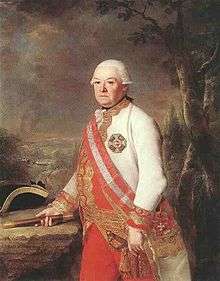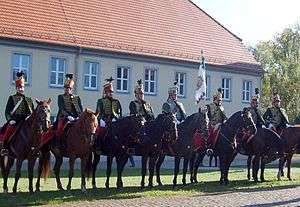András Hadik
Count András Hadik de Futak (German: Andreas Reichsgraf Hadik von Futak; Hungarian: futaki Hadik András gróf; Slovak: Andrej Hadík; October 16, 1710 – March 12, 1790) was a Hungarian nobleman[1] and Field Marshal[2] of the Habsburg Army. He was Governor of Galicia and Lodomeria from January 1774 to June 1774, and the father of Karl Joseph Hadik von Futak. He is famous for capturing the Prussian capital Berlin during the Seven Years' War.
András Hadik | |
|---|---|
 Andreas Hadik (by Georg Weikert, 1783) | |
| Born | October 16, 1710 |
| Died | March 12, 1790 (aged 79) |
| Nationality | Hungarian |
| Occupation | Field Marshal of the Habsburg Army, Governor of Galicia and Lodomeria |
| Known for | Capturing the Prussian capital Berlin in the Seven Years' War |
| Relatives | Karl Joseph Hadik von Futak |
Early life
András Hadik, son of a lesser noble family, was born on October 16, 1710, in Csallóköz (then Kingdom of Hungary, now Žitný ostrov in Slovakia) or in Kőszeg, Kingdom of Hungary. He had Hungarian,[3][4][5][6] Luxembourgian[5] and Slovak[7] ancestors. According to another source, he was of Hungarian ethnic origin, but the name "Hadik" is a diminutive from the Slovak appellative had ("snake"), the family was thus of Slovak extraction.[8] Alternative theories also suggest his Tartar or Cherkess ancestry.[9]
His father, Mihály Hadik was a cavalryman. His mother, Franciska Hardy had a German background.[5] András Hadik volunteered for the Ghilányi Hussar regiment when he was 20, and at 22 he was given the rank of officer and became the standard bearer in the Dessewffy Hussar regiment in the Habsburg army. Hadik fought in the War of the Polish Succession (1733–1738) and the Austro-Turkish War, 1737-1739. In 1738 Hadik was promoted to the rank of captain.
Military successes
During the War of the Austrian Succession (1740–1748) he gained fame for his actions against the Prussians at the city of Neisse (Nysa, now Poland) using surprise attacks and tricks under the unwritten laws of the so-called "small war," relying on the excellent training of his light cavalry hussars. During the war he served under Prince Charles Alexander of Lorraine and was promoted to the rank of Lieutenant-Colonel. In 1744 he gained the rank of Commanding Colonel of his own hussar regiment, then near the end of the war in 1747 he attained the rank of General and was appointed commander of a cavalry brigade.
Early in the Seven Years' War (1756–1763), Hadik executed the most famous hussar action in history: when the Prussian King Frederick was marching south with his powerful armies, the Hungarian general unexpectedly swung his 5,000 force of mostly hussars around the Prussians and took their capital Berlin. The city was spared for a negotiated ransom of 300,000 thalers,[2] which he distributed among his troops. For this feat, Hadik was promoted to the rank of Field Marshal. He was also awarded the Großkreuz of the Maria Theresia Order.[2]
Legacy
Slovak National Academy of Defense of Marshal Andrej Hadík (2004–2008) was named after him.[10]
Image gallery
 Hungarian Hadik-Hussars in Germany, 2007
Hungarian Hadik-Hussars in Germany, 2007- András Hadik prize
 András Hadik
András Hadik András Hadik
András Hadik- András Hadik's sculpture in Budapest
References
- Michael Hochedlinger Austria's wars of emergence: war, state and society in the Habsburg monarchy. 2003. accessed August 13. 2011. p. 318
- Darrell Berg (editor): The Correspondence of Christian Gottfried Krause: A Music Lover in the Age Sensibility, Ashgate Publishing Ltd, 2009
- Décsy, Gyula (2004). Eurasian studies yearbook. Volume 76. Eurolingua.
Andreas Hadik (1710–1790)was an Austrian fieldmarshall of Hungarian ethnic origin"
- Hadik's ancestry is based on -rp- "Egy hires magyar katona eletutja... "The Carrier of a Famous Hungarian Soldier.' in Hadak Utjan, ..On the Milky Way of Hosts.." (Munchen, Vol. XVII, No. 139, November, 1965,) pp. 13–15.
- Mária Terézia hadvezére (Maria Terezia's general), Válogatás Hadik András táborszernagy Hadtörténelmi Levéltárban őrzött irataiból(Winnowing from András Hadik Colonel-General's kept records in The Record Office of the Ministry of Defence, (Hungary))/ [Editor: Gyongyi Farkas], 2000. Cited sentences(translation): "His father was a cavalrymen with Hungarian ancestry. Franciska Hardy had Luxembourgian ancestry and German vernacular."
- Nagy, Iván; Friebeisz, István (1859). Magyarország családai: Czimerekkel és nemzékrendi táblákkal (in Hungarian). 11. Pest: Friebeisz I. pp. 6–14. OCLC 05769841. Alt URL/According to this source the Hadik family is an ancestral Hungarian family (page 6)/
- Új látóhatár, Zväzok 33, Vydanie 2.,J. Molnár, 1982., p. 161
- Décsy, Gyula (2004). Eurasian studies yearbook. Volume 76. Eurolingua.
The name Hadik is a diminutive from the Slovak appellative had 'snake'. The family was thus of Slovak extraction — although he (Hadik) is often regarded as the incarnation of Magyar military genius.
- In remembrance of András Hadik Archived March 31, 2012, at the Wayback Machine, Military Intelligence Office of Republic of Hungary Archived July 22, 2010, at the Wayback Machine
- "History of the Armed Forces Academy of Milan Rastislav Štefánik". Armed Forces Academy of Milan Rastislav Štefánik. Retrieved 2 December 2016.
- colnect.com/en/stamps/stamp/179987-Count_András_Hadik_1710-1790_field_marshal-Characters_and_Relics_of_Hungarian_History-Hungary
- colnect.com/en/stamps/stamp/206307-Count_András_Hadik_1710-1790_field_marshal-Liberation_of_Hungary-Hungary
- colnect.com/en/stamps/stamp/179874-Count_András_Hadik_1710-1790_field_marshal-Overprinted-Hungary
External links
| Wikimedia Commons has media related to András Hadik. |
- https://web.archive.org/web/20110126233135/http://hungarian-history.hu/lib/thou/thou08.htm
- http://www.worldstatesmen.org/Poland.htm
- http://www.napoleon-series.org/reviews/military/c_duffy.html
- http://www.militaryheritage.com/hadiksword.htm
- Records about András Hadik (Maria Terezia's general, second volume, 2002. Editor: Gyongyi Farkas) (In Hungarian)
- . New International Encyclopedia. 1905.